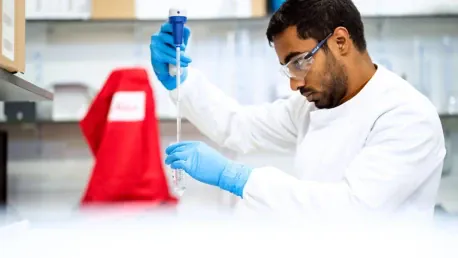MilliporeSigma, the Life Science business of Merck KGaA in the U.S. and Canada, has announced a definitive agreement to acquire HUB Organoids Holding B.V. (HUB). This acquisition marks a significant step forward in enhancing their 2D and 3D cell culture portfolio with the innovative technology of organoids. Organoids are three-dimensional cell culture models that mimic the functional properties of actual organs, offering immense potential in drug development and disease treatment research.
Strategic Acquisition to Enhance Cell Culture Portfolio
The Promise of Organoids
Organoids represent a breakthrough in biological research, providing a more accurate model of human organs compared to traditional 2D cell cultures. These 3D models can accelerate drug development, improve understanding of disease mechanisms, and reduce the need for animal testing. HUB, based in Utrecht, Netherlands, is a pioneer in this field, employing around 70 people and renowned for its advancements in organoid technology. By integrating HUB’s innovative approaches, MilliporeSigma aims to significantly expand its current portfolio of cell culture tools.
The enhancement provided by organoids doesn’t just stop at mimicking organ functions; it extends into creating diverse opportunities for human-relevant discoveries in cancer research and personalized medicine. The precision that organoids offer makes it possible to study disease progressions in ways that were previously unimaginable with 2D cultures. This groundbreaking technology suggests a future where treatments can be tailored more effectively to individual patient needs, thereby improving clinical outcomes. The acquisition of HUB implies that MilliporeSigma is making strong strategic moves toward staying at the cutting edge of cell culture innovations.
Bridging Laboratory Research and Clinical Trials
A key aspect of this acquisition is the potential of organoids to bridge the gap between laboratory research and clinical trials. HUB’s fundamental patent portfolio and service offerings, including new model generation, assay development, and high-throughput screening, will significantly enhance Merck KGaA’s existing suite of cell culture tools and reagents. The transaction is expected to be completed by the end of December 2024, although financial terms were not disclosed.
Drug development has historically faced the challenge of translating promising laboratory findings into successful clinical trials. Organoids can mitigate this issue by providing more reliable models for safety and efficacy assessments before moving on to human subjects. This not only accelerates the drug development timeline but also reduces costs and increases the likelihood of clinical success. HUB’s capabilities in this area will thus greatly benefit Merck KGaA’s mission to deliver more reliable and effective treatments to the market.
Enhancing Drug Development and Disease Research
Jean-Charles Wirth’s Vision
Jean-Charles Wirth, Head of Science & Lab Solutions for Merck KGaA’s Life Science business, expressed enthusiasm for the enhanced portfolio’s potential to aid researchers dealing with complex diseases. He emphasized that the acquisition aligns with strategic innovation goals focusing on next-generation biological solutions, aiming to streamline paths from samples to solutions for scientific communities. Wirth believes that the addition of HUB’s capabilities will usher in a new era of biological research and drug discovery, marked by increased efficiency and precision.
Wirth’s vision extends beyond mere operational expansion; it aims for a transformative impact on how life sciences research is conducted. By leveraging HUB’s proprietary organoid technology, researchers will be equipped to delve deeper into fundamental questions about disease mechanisms and treatment responses. The resulting data sets, more representative of human biology than traditional models, are expected to facilitate breakthroughs in understanding and treating diseases that have long eluded effective intervention. This strategic alignment underscores the commitment to pioneering solutions that advance global health outcomes.
HUB’s Proprietary Technology
HUB’s unique proprietary technology offers a paradigm shift in drug discovery and development. By providing drug developers with the ability to conduct more effective clinical candidate testing through patient-relevant in vitro systems, this technology can significantly improve the drug development process. CEO Robert Vries of HUB Organoids highlighted that Merck KGaA’s resources will amplify HUB’s business reach and impact, particularly toward customers and patients.
The proprietary nature of HUB’s technology holds promise for creating more predictive models of human physiology, allowing for earlier identification of potential therapeutic candidates. The combination of HUB’s innovative organoid systems and Merck KGaA’s extensive resources is set to revolutionize the landscape of personalized medicine and targeted therapies. This collaboration also opens doors for novel approaches in regenerative medicine, offering substantial benefits for patients needing organ replacements or advanced treatments for degenerative diseases. The anticipated ripple effects of this acquisition are likely to be felt across the healthcare industry.
Commitment to Sustainability and Inclusion
Reducing Animal Testing
The acquisition also contributes to sustainability goals by potentially reducing the reliance on animal testing in the R&D process. Organoids offer a more environmentally sustainable approach to research, aligning with broader efforts to minimize the ethical and environmental impact of scientific studies. The ability to use human-derived organoids in place of animals for testing not only reduces ethical concerns but also provides more relevant and accurate data for human health applications. This shift is seen as a critical step towards more humane and effective scientific practices.
The environmental benefits of reducing animal testing are considerable. Resource-intensive processes involving the breeding, upkeep, and disposal of lab animals create a significant ecological footprint. By pivoting to organoid models, the industry can decrease this footprint while improving the reproducibility and relevance of experimental outcomes. This makes organoids not only a scientific advancement but also a responsible choice for future R&D practices. Such sustainability measures contribute to the greater discourse on ethical research, emphasizing the need to balance innovation with ecological and moral responsibilities.
Enhancing Diversity in Research
Organoids provide opportunities to include more genetically diverse populations in research, thereby enhancing the understanding of drug interactions within underrepresented groups in clinical trials. This inclusivity is crucial for developing treatments that are effective across diverse populations, addressing a significant gap in current medical research. With organoids derived from a variety of human donors, researchers can better study the genetics behind different responses to treatments, leading to more effective and inclusive healthcare solutions.
The inclusion of diverse genetic backgrounds in research through organoids also has the potential to correct historical imbalances in clinical trial demographics. As a result, the findings and new treatments will likely benefit a broader range of patients, leading to more equitable healthcare outcomes. This approach can pave the way for medicines that are safer and more effective for all, rather than just the majority populations historically overrepresented in research studies. The value of such inclusive research is manifold, offering the promise of more personalized and effective medical care for everyone.
Merck KGaA’s Legacy and Future Ambitions
Historical Context and Market Presence
Since its inception in 1668, Merck KGaA has prioritized scientific exploration and responsible entrepreneurship. The company maintains a strong market presence under the Merck trademark globally, except in the United States and Canada, where it operates under brands such as MilliporeSigma, EMD Serono, and EMD Electronics. The Life Science business employs over 28,000 people, managing over 55 manufacturing and testing sites globally with a diverse portfolio exceeding 300,000 products.
The historical legacy of Merck KGaA speaks to its longstanding commitment to innovation and quality. Over the centuries, the company has adapted to changing scientific landscapes, always at the forefront of technological advancements. This latest move to acquire HUB is seen as a continuation of this legacy, reinvesting in cutting-edge technologies to maintain its competitive edge. Such strategic initiatives are crucial for sustaining growth and relevance in the rapidly evolving fields of life sciences and biotechnology.
Innovations in 3D Cell Culture
The Life Science business of Merck KGaA has been at the forefront of innovations in 3D cell culture, boasting a portfolio that includes tumor spheroids, stem cell organoids, and tissue engineering through 3D bioprinting. Their cell culture fundamentals, coupled with downstream analysis reagents and a complete drug development portfolio, are crucial for aiding biotech, pharma, and academia researchers. Specific examples of their offerings include filtration, media, serum, culture plates, cell lines, microbial detection, cytokines, and growth factors.
Merck KGaA’s investments in 3D cell culture technologies have already yielded significant advancements in cancer research and regenerative medicine. The ability to create complex tissue models has opened up new avenues for studying intricate cellular interactions. For biotech and pharmaceutical companies, these 3D models offer unparalleled opportunities for drug testing and development, reducing failure rates in clinical trials and speeding up the time to market for new therapies. The ongoing expansion in this sector underscores Merck KGaA’s commitment to staying ahead in the competitive scientific arena.
HUB Organoids’ Leadership in Stem Cell-Derived Technologies
Driving Change in Drug Discovery
HUB Organoids Holding B.V. is a leader in adult stem cell-derived organoid technologies, driving change in various aspects of drug discovery, preclinical patient stratification, personalized medicine, and regenerative medicine. HUB offers licenses to its proprietary technology and delivers drug development services leveraging its living organoid biobanks. The potential applications of their technology are vast, ranging from basic research to clinical applications, offering unprecedented insights into human biology.
The revolutionary work being done by HUB in stem cell-derived organoids is paving the way for more precise medical interventions. These organoids serve not only as research tools but also as potential therapeutic avenues in regenerative medicine. For instance, the ability to generate patient-specific organoids opens up possibilities for personalized treatments tailored to individual genetic makeups. Such advancements hold the promise of more successful outcomes in both common and rare diseases, transforming the landscape of medical treatments and healthcare approaches.
Expanding Impact with Merck KGaA’s Resources
MilliporeSigma, the Life Science division of Merck KGaA operating in the U.S. and Canada, has announced a definitive agreement to acquire HUB Organoids Holding B.V. (HUB). This acquisition represents a significant advancement in enhancing MilliporeSigma’s 2D and 3D cell culture portfolio by incorporating HUB’s groundbreaking organoid technology. Organoids are three-dimensional cell culture models that closely replicate the functional characteristics of real organs. This innovative technology holds tremendous promise for drug development and disease research, as it enables more accurate simulation of human organ functions. By integrating HUB’s organoid technology, MilliporeSigma aims to significantly improve their capabilities in creating sophisticated cell culture solutions. This acquisition not only strengthens their existing portfolio but also reinforces their commitment to advancing life science research and developing innovative solutions for better understanding diseases and discovering effective treatments.









